AMD Ryzen 9 5980HS Cezanne Review: Ryzen 5000 Mobile Tested
by Dr. Ian Cutress on January 26, 2021 9:00 AM EST- Posted in
- CPUs
- AMD
- Vega
- Ryzen
- Zen 3
- Renoir
- Notebook
- Ryzen 9 5980HS
- Ryzen 5000 Mobile
- Cezanne
CPU Tests: Simulation
Simulation and Science have a lot of overlap in the benchmarking world, however for this distinction we’re separating into two segments mostly based on the utility of the resulting data. The benchmarks that fall under Science have a distinct use for the data they output – in our Simulation section, these act more like synthetics but at some level are still trying to simulate a given environment.
DigiCortex v1.35: link
DigiCortex is a pet project for the visualization of neuron and synapse activity in the brain. The software comes with a variety of benchmark modes, and we take the small benchmark which runs a 32k neuron/1.8B synapse simulation, similar to a small slug.
The results on the output are given as a fraction of whether the system can simulate in real-time, so anything above a value of one is suitable for real-time work. The benchmark offers a 'no firing synapse' mode, which in essence detects DRAM and bus speed, however we take the firing mode which adds CPU work with every firing.
The software originally shipped with a benchmark that recorded the first few cycles and output a result. So while fast multi-threaded processors this made the benchmark last less than a few seconds, slow dual-core processors could be running for almost an hour. There is also the issue of DigiCortex starting with a base neuron/synapse map in ‘off mode’, giving a high result in the first few cycles as none of the nodes are currently active. We found that the performance settles down into a steady state after a while (when the model is actively in use), so we asked the author to allow for a ‘warm-up’ phase and for the benchmark to be the average over a second sample time.
For our test, we give the benchmark 20000 cycles to warm up and then take the data over the next 10000 cycles seconds for the test – on a modern processor this takes 30 seconds and 150 seconds respectively. This is then repeated a minimum of 10 times, with the first three results rejected. Results are shown as a multiple of real-time calculation.
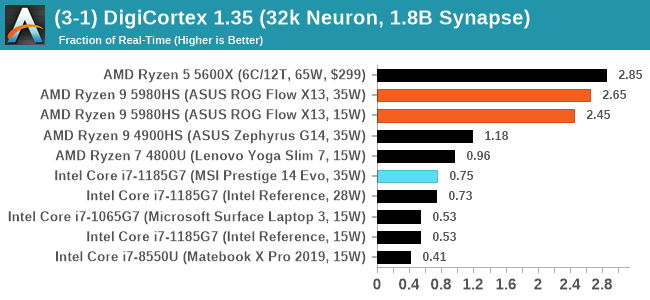
DigiCortex seems to have taken a shine to Zen 3, especially processors with a single chiplet of cores. Intel can't seem to compete here.
Dwarf Fortress 0.44.12: Link
Another long standing request for our benchmark suite has been Dwarf Fortress, a popular management/roguelike indie video game, first launched in 2006 and still being regularly updated today, aiming for a Steam launch sometime in the future.
Emulating the ASCII interfaces of old, this title is a rather complex beast, which can generate environments subject to millennia of rule, famous faces, peasants, and key historical figures and events. The further you get into the game, depending on the size of the world, the slower it becomes as it has to simulate more famous people, more world events, and the natural way that humanoid creatures take over an environment. Like some kind of virus.
For our test we’re using DFMark. DFMark is a benchmark built by vorsgren on the Bay12Forums that gives two different modes built on DFHack: world generation and embark. These tests can be configured, but range anywhere from 3 minutes to several hours. After analyzing the test, we ended up going for three different world generation sizes:
- Small, a 65x65 world with 250 years, 10 civilizations and 4 megabeasts
- Medium, a 127x127 world with 550 years, 10 civilizations and 4 megabeasts
- Large, a 257x257 world with 550 years, 40 civilizations and 10 megabeasts
DFMark outputs the time to run any given test, so this is what we use for the output. We loop the small test for as many times possible in 10 minutes, the medium test for as many times in 30 minutes, and the large test for as many times in an hour.
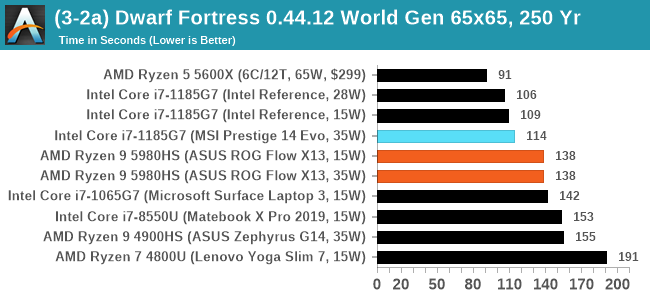
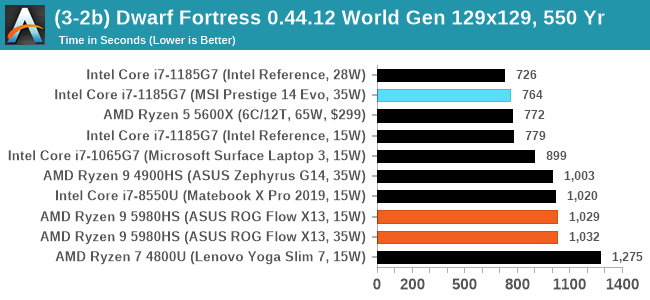
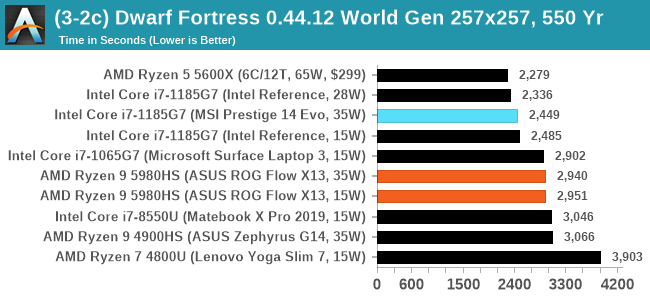
DF has historically been an Intel favorite, and we're not seeing much of a speedup for mobile Zen 3 over mobile Zen 2 here.
Dolphin v5.0 Emulation: Link
Many emulators are often bound by single thread CPU performance, and general reports tended to suggest that Haswell provided a significant boost to emulator performance. This benchmark runs a Wii program that ray traces a complex 3D scene inside the Dolphin Wii emulator. Performance on this benchmark is a good proxy of the speed of Dolphin CPU emulation, which is an intensive single core task using most aspects of a CPU. Results are given in seconds, where the Wii itself scores 1051 seconds.
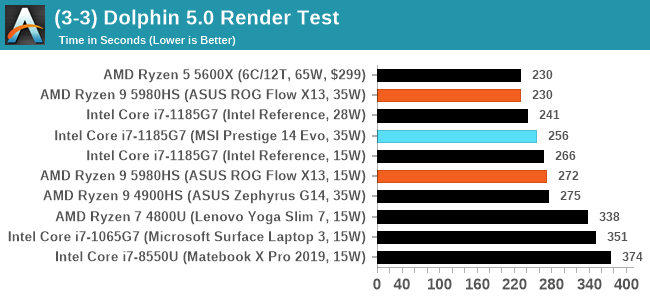
The 35W variant of Cezanne pushes through here, matching the desktop processor, and a sizeable performance jump over the previous generation Renoir.












218 Comments
View All Comments
Deicidium369 - Wednesday, January 27, 2021 - link
Would bet that fourth world country has flush toilets...GeoffreyA - Thursday, January 28, 2021 - link
Deicidium, none of us is better than the next person.Spunjji - Thursday, January 28, 2021 - link
Nice racism there, shitlord.GreenReaper - Saturday, January 30, 2021 - link
Just wait until you hear what the Japanese think about everyone else's toilets. ಠ_ಠSpunjji - Monday, February 1, 2021 - link
🤣bji - Wednesday, January 27, 2021 - link
That price is significantly above US MSRP.It is significantly above the price listed by Anandtech whenever they do chip comparisons.
Spunjji - Thursday, January 28, 2021 - link
Why would chips in India be selling at US MSRP? It's about the same as the UK / EU price.bji - Thursday, January 28, 2021 - link
As you can see everyone and their brother just writes in a tangent to the actual issue. Bring up supply issues in the USA, people start posting about buying the chip in India or Europe. Bring up price markups in USA, people start mentioning prices in other countries whose price is only vaguely related to USA prices. Bring up the fact that Ananadtech is supplying misleading information when it puts prices in its articles, people ask about chips in India vs US MSRP and UK/EU price. The actual issues are constantly ignored by everyone wanting to post some tangentially related information local to them. Whatever.Spunjji - Thursday, January 28, 2021 - link
@bji - The end of your original post:"The simple fact is that no Ryzen 3(sic) processors have had general availability at anywhere near MSRP for months."
So yeah, it's pretty relevant for people who don't live in the USA to respond by pointing out that there is availability at or around MSRP where they live. It's equally relevant to point out you're wrong when you respond by saying "that's not MSRP" as if everyone pays the same equivalent dollar price at retail as you do in the USA.
"The actual issues are constantly ignored..."
This is a neat way of saying "let me complain regardless of the facts outside of the USA". These responses aren't "tangential" for the people posting them. If you want to only talk about the USA, make that clear from the start.
Nottheface - Saturday, January 30, 2021 - link
Move obviously.